Policy and approach
As climate change, the sustainability of natural resources, the increasing number of natural disasters, and other environmental issues become more diverse, companies are facing strong demand to demonstrate their problem-solving capabilities. Under these circumstances, and as a company that contributes to people’s healthy and vibrant lives from food to housing, Nichimo considers the natural environment and its resources and contributes to the realization of a sustainable society through reliable technologies and services in multiple business segments, namely food, marine, machinery, and materials.
Response to Climate Change and Information Disclosure Based on the TCFD Recommendations
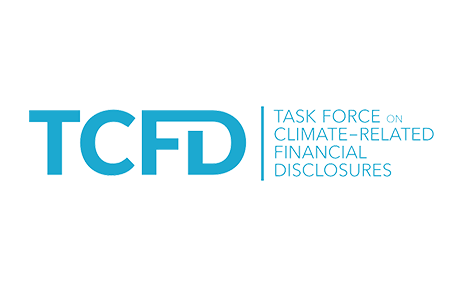
Support for the TCFD Recommendations
Nichimo is promoting sustainable management under its Fiscal 2023 Medium-Term Management Plan, which started in April 2022. As one of the specific initiatives under this plan, the Company has recognized the issue of climate change as an important management issue. In April 2023 we announced our agreement with the TCFD* Recommendations. The Company will provide appropriate information disclosure in line with the TCFD’s recommended disclosure themes of “governance,” “risk management,” “strategy,” and “metrics and targets.” In addition, going forward we will strive to enhance our information disclosure even further, including the evaluation of financial impacts.
- *TCFD (Task Force on Climate-related Financial Disclosures)
:Task Force on Climate-related Financial Disclosures
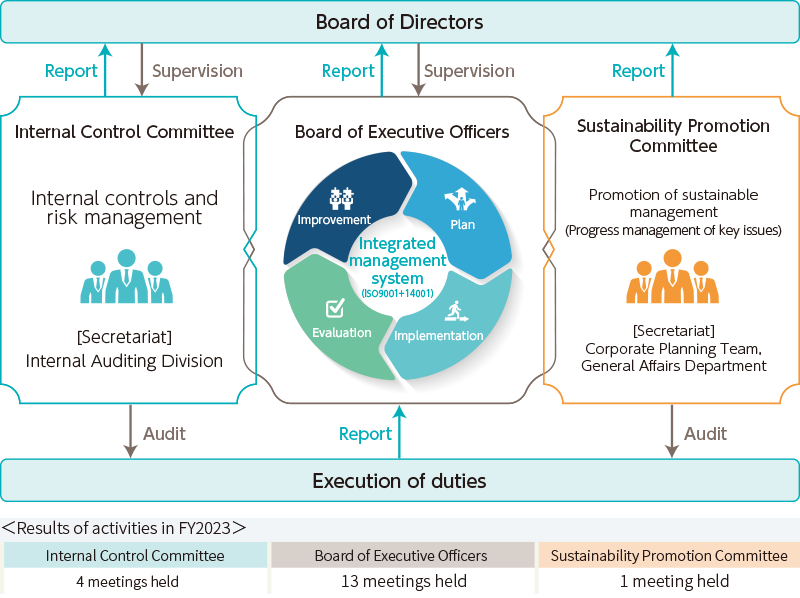
Governance
In promoting sustainable management, the Company acquired ISO Integrated Management System (ISO 9001 + 14001) certificate in October 2022, and is conducting initiatives with an emphasis on quality and environmental consideration. Because these efforts are put into action in individual departments, they foster an awareness of sustainability among employees as well as management, meaning that the entire Company works to contribute to the realization of a sustainable society.
As head of the secretariat for this ISO integrated management system, Senior Managing Director serves as the person responsible for ISO management, setting targets for quality and environmentally considerate corporate activities each year in April at the Board of Executive Officers, which is made up of 10 Executive Officers (including Directors). Progress on these targets is checked every quarter, four times a year. The ISO secretariat makes a report in the form of a management review to the Representative Director and President. Looking ahead, the Company will promote sustainable management across the entire company with the aim of building a structure for reporting to the Board of Directors.
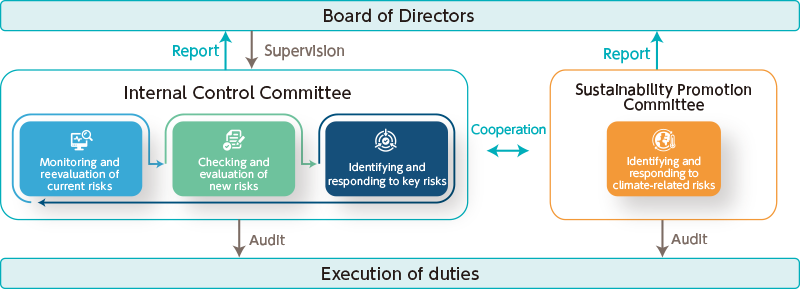
Risk management
The identification, evaluation, and determination of policy for specific risks facing the Company is the role of the Internal Control Committee. The Company has also formulated Crisis Management Guidelines to deal with unexpected problems, and has established systems to enable a rapid response in the event of an unforeseen situation, and prevent losses from expanding as much as possible.
The Internal Control Committee meets four times a year under the supervision of the Board of Directors and is chaired by the Representative Director and President. In 2023, the committee started to evaluate the impact on its businesses of risks and opportunities associated with climate change. The committee will expand its initiatives going forward, including disclosure of financial impacts.
Strategy
Following the framework advocated by the TCFD, the Company has identified and evaluated the future impacts of climate change on its business using the scenario analysis approach. In its scenario analysis, the Company has referred to multiple existing scenarios announced by the International Energy Agency (IEA) and the Intergovernmental Panel on Climate Change (IPCC).
*Please scroll sideways.
| Risk / opportunity type | Risk / opportunity causal factors | Business impact | Time frame | Probability of occurrence | Degree of influence | Overall evaluation | Amount of impact | ||
|---|---|---|---|---|---|---|---|---|---|
| Risks | Transition risks | Policies, and laws and regulations | Introduction of carbon pricing |
If carbon pricing is introduced, it could increase the procurement cost of fossil fuels. Basis for calculation of quantitative financial impact Calculated by multiplying the projected Scope 1 emissions volumes in FY2030 and FY2050 by the carbon tax price per t-CO2 |
Medium term | High | Medium | Large | 1.5°C scenario test calculation result 2030: 0.08 billion yen 2050: 0.14 billion yen |
| Tightening of renewable energy procurement ratio regulations | If renewable energy procurement ratio regulations are tightened, renewable energy development costs and procurement costs, such as J-Credits and Green Electricity Certificates, could increase.
Basis for calculation of quantitative financial impact Assuming SBT’s 1.5°C level, calculated for the purchase of renewable energy certificates for Scope 2 emissions volume in 2030 |
Medium term | High | Medium | Large | 1.5°C scenario test calculation result 2030: 0.02 billion yen |
|||
| Tightening of regulations on fossil fuel-based plastics | If regulations on fossil fuel-based plastics are tightened, the procurement cost of plastic material such as nylon and polyester used in equipment and materials could increase. | Medium term | High | Medium | Large | ||||
| Technology | Mainstream adoption of aquaculture technology for responding to climate change | Climate change could cause an impact such as a sharp decrease in fish catch due to factors such as increased seawater temperature, changes in migration routes of marine animals, and ocean acidification. In such a case, aquaculture technologies for responding to climate change will be needed, but if the Company is too slow to respond to these technologies, production costs could increase. | Short term | High | Large | Large | |||
| Market | Increase in demand for environmentally friendly products | Needs for procurement of environmentally friendly marine materials may increase going forward. If the Company is unable to supply appropriate products, it may experience a decrease in sales and profits due to a decline in demand for marine products and fishing nets, fishing gear, and machinery and materials that cannot be certified as being environmentally friendly, leading to a loss of market share. | Medium term | Medium | Medium | Medium | |||
| Needs for procurement of environmentally friendly aquaculture seedlings and feed may increase going forward. If the Company is unable to supply appropriate products, it may experience a decrease in sales and profits due to a decline in demand for products that cannot be certified as being environmentally friendly, leading to a loss of market share. | Medium term | Medium | Large | Large | |||||
| Physical risks | Acute physical risks | Intensification of abnormal weather | Some of the Company’s main aquaculture and processing facilities are in coastal areas that are around 2 to 5 meters above sea level. If the frequency of typhoons, floods, and so forth increases due to climate change, operations may be suspended due to the damage or destruction of facilities, which could cause sales and profits to decrease.
Basis for calculation of quantitative financial impact Calculated by multiplying the amount of lost sales from suspended operations following past natural disasters by the frequency of flood events |
Short term | Medium | Medium | Medium | 2°C scenario test calculation result up to 2050: 0.78 billion yen 4°C scenario test calculation result up to 2050: 2.35 billion yen |
|
| Chronic physical risks | Change in growing environment due to climate change | A decline in natural fish catches and marine aquaculture production volumes due to changes in the ocean environment, such as increased seawater temperature, could cause a decrease in sales and profits. | Short term | Medium | Medium | Large | |||
| Opportunity | Products and services | Shift in preferences toward certified products and low-carbon products (land-based aquaculture) | Land-based aquaculture is unaffected by external environmental changes, such as seawater temperature change due to global warming, and provides stable production in a low-energy ecosystem, which could lead to increased sales and profits. | Short term | High | Large | Large | ||
| Shift in preferences toward environmentally friendly machinery and materials | An increase in demand for certified environmentally friendly caught fish, marine products, and farmed fish as well as environmentally friendly machinery and materials, could lead to increased sales and profits. | Medium term | Medium | Medium | Medium | ||||
| Shift in preferences to low-carbon products (Biomass fishing nets) |
The Company has been engaged in development of marine materials made with biomass and biodegradable materials, which reduce CO2 emissions during production and disposal by approximately 50% compared with existing petroleum based materials. If regulations concerning these plastics are tightened, it could lead to increased sales and profits. | Short term | High | Medium | Large | ||||
| Shift in preferences to low-carbon products (Recycled plastic) |
The Company is engaged in building a network for recycling waste fishing nets. Since the project involves manufacturing high quality recycled pellets, if regulations concerning plastics are tightened, it could lead to increased sales and profits. | Short term | Medium | Medium | Medium | ||||
| Market | Participation in the blue carbon market | The provision of materials and consulting for algae bed formation, as well as sales of blue carbon credits could lead to increased sales and profits. | Medium term | Medium | Medium | Medium | |||
| FY2021 (t-CO2) |
||
|---|---|---|
| Scope 1 | Business operator’s direct greenhouse gas emissions | 4,533 |
| Scope 2 (Market standards) |
Indirect emissions associated with the use of electricity, heat, and steam supplied by other companies | 6,109 |
| Scope 2 (Location standards) |
5,287 | |
| Subtotal of Scopes 1+2 (Market standards) | 10,642 | |
| Subtotal of Scopes 1+2 (Location standards) | 9,820 | |
- *Scopes 1 and 2 were calculated in line with GHG Protocol. The Scope 1 and 2 calculations covered main locations in Japan, including those of consolidated subsidiaries. Business locations and sales offices were not included in the Scope 1 and 2 calculations.
- * Chlorofluorocarbon emissions were not included in Scope 1 calculations this time.
- * We recognize the next challenge is to make calculations including Scope 3 emissions, and we will continue working to expand the calculation scope.
Benchmarks and targets
The Company is discussing the setting of benchmarks and targets regarding its response to climate change. As part of this, we have started ascertaining our greenhouse gas emissions. We calculated Scope 1 (fuel) and Scope 2 (electricity) emissions for Nichimo and its main consolidated subsidiaries, based on FY2021 energy consumption performance. A breakdown is presented in the table to the right. We will continue to expand the scope of our calculation and to enhance our climate change response going forward.
Conserving fishery resources
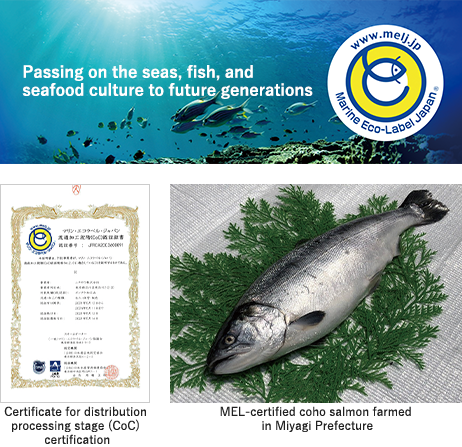
Acquisition of Marine Eco-Label (MEL) certification
Nichimo works to provide safe, sustainable food in harmony with the marine environment by conserving fishery resources and ecosystems and establishing traceability. As part of these efforts, in May 2021, the Company acquired MEL certification from the Marine Eco-Label Japan Council for the distribution processing stages of processed coho salmon farmed in Miyagi Prefecture.
Marine Eco-Label Japan (MEL) certifies that companies in the fishing and aquaculture industries are conserving resources and ecosystems so that these can be optimally used by generations into the future. Certified products are distributed with the MEL logomark. MEL’s mission is to “help protect the richness of the seas and contribute to new development of Japan’s marine products industry and to the achievement of the SDGs.” MEL, which is approved by the Global Sustainable Seafood Initiative (GSSI), is a de facto international sourcing standard, having been adopted by major retailers and other companies around the world, and is expected to help improve international reputations and contribute to the promotion of more exporting.
Within the Group, Nichimo Mariculture Co., Ltd. obtained certification in April 2020 at the production stage for coho salmon farmed in Miyagi Prefecture, a goal that has been worked on for many years. The Company also acquired certification to integrate production and sales, thereby realizing a system for supplying sustainable marine products.
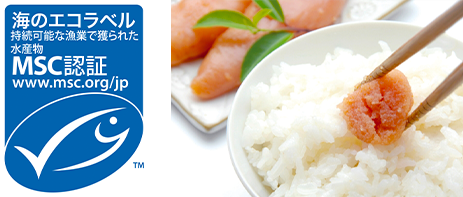
Acquisition of Marine Stewardship Council Chain of Custody (MSC CoC) certification
There are two types of MSC certification: MSC Fisheries certification for companies that engage in sustainable fishing operations that are properly managed in terms of consideration for fishery resources and the environment, and MSC CoC certification for the supply chains used to reliably deliver the marine products of MSC-certified companies in the fishing industry to consumers. Marine products featuring the blue MSC label are sourced by companies in the fishing industry certified by an independent examining authority as taking proper considerations for fishery resources and the environment.
The Company acquired MSC CoC certification for its handling of MSC-certified pollack roe, crab, and fresh and frozen products, and supplies both whole and processed foods to contribute to the supply of sustainable marine products with consideration for fishery resources and the environment.
Introducing energy-saving,
eco-friendly equipment
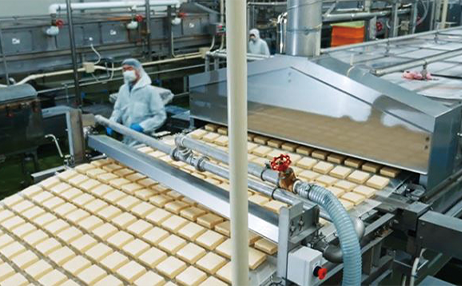
Fried tofu maker with a heat exchange fryer
Nichimo is making progress with efforts to introduce energy-saving, eco-friendly equipment. For example, for the tofu fryers on fried tofu production lines, the Company uses heat exchange equipment—over 40% more thermally efficient than the conventional open-flame fryers—to reduce running costs, save energy, and cut CO2 emissions.
The Company also supplies equipment for removing the steam and oily smoke generated by cooking to reduce foul odors emitted from factories and contribute to the conservation of living environments in the communities around them.
